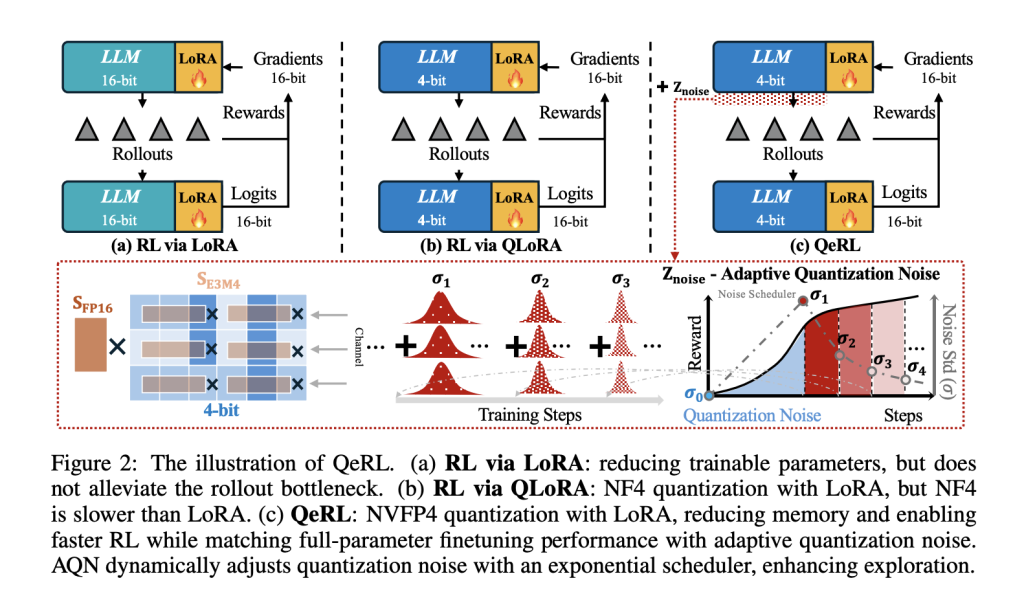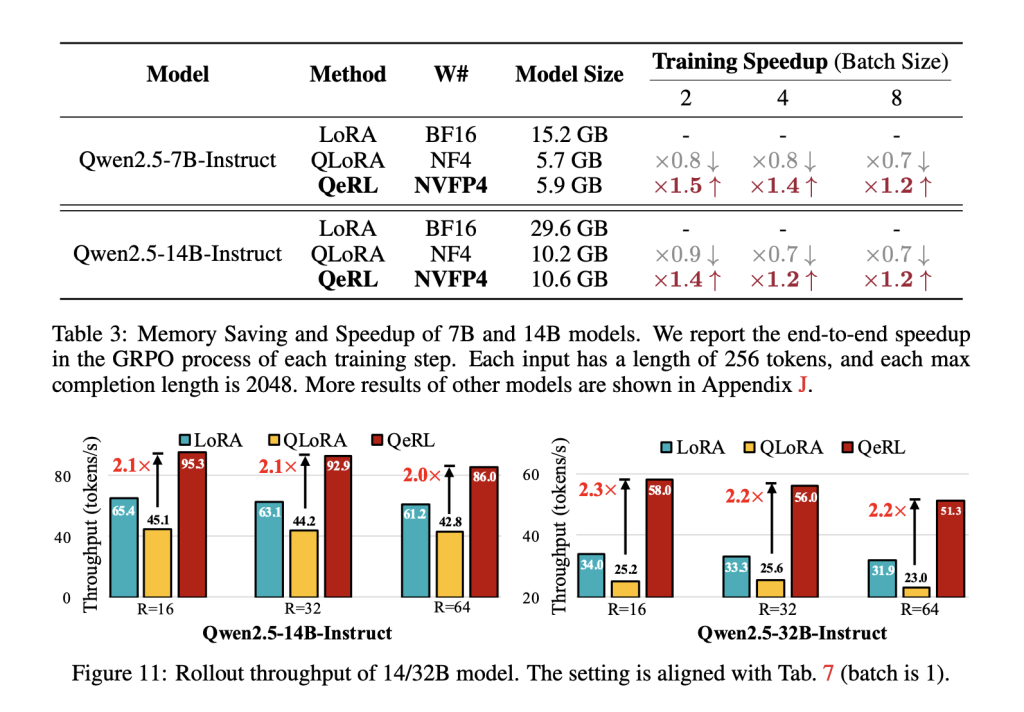Picture this: You’re knee-deep in debugging an RL pipeline for a 32B LLM, your H100 GPU’s fans screaming like a jet engine, and yet another out-of-memory error crashes your session. Rollouts drag on for hours, rewards barely budge, and your electricity bill rivals a small country’s GDP. Sound familiar? As an AI dev, I’ve been there—staring at frozen progress bars, wondering if true reasoning in large language models is just a pipe dream. But what if I told you there’s an open-source framework that tames this beast on one H100, slashes training time by up to 2x, and—get this—turns quantization noise into a secret weapon for better exploration? Enter QeRL, NVIDIA’s game-changer that’s making reinforcement learning (RL) for LLMs accessible, efficient, and downright smart.
In this post, we’ll dive into QeRL’s magic: how NVFP4 quantization + LoRA supercharges RL without sacrificing accuracy, why that “pesky” quantization noise actually boosts policy entropy for faster reward gains, and a hands-on guide to get you training 32B models today. If you’re optimizing LLM RL training, scaling reasoning tasks like math puzzles or code gen, or just battling GPU limits, stick around—this could be the efficiency hack your workflow’s been craving.
The RL Training Trap: Why Your LLM’s “Thinking” Feels Like a Resource Black Hole
Let’s set the scene. Supervised fine-tuning (SFT) is the reliable sidekick: Feed it reasoning traces, and your LLM spits out polished outputs. But for genuine multi-step reasoning—cracking GSM8K math problems or debugging complex code—RL is the real MVP. It uses reward signals to guide exploration, letting models discover robust strategies beyond rote imitation.
The catch? RL is a GPU vampire. Algorithms like GRPO demand parallel runs of policy and reference models, ballooning memory for 32B beasts to 60GB+. Rollouts—the token-sampling marathon for long reasoning chains—eat 80% of your time. I’ve lost nights to this: A 7B model on math tasks, and rollouts alone take 30 minutes per batch, trapping the policy in local optima with zero exploration spark.
Legacy fixes fall short. LoRA shines for parameter efficiency, trimming trainable params to millions, but rollouts limp along in BF16. QLoRA’s NF4 quantization cuts memory but tanks speed 1.5-2x thanks to lookup-table unpacking. Tools like FlashRL juggle quantized and full-precision models for bias correction, spiking memory higher. No wonder scaling RL to 32B feels like herding cats—until QeRL flips the script.

QeRL’s RL loop in action: NVFP4 accelerates rollouts via Marlin kernels, LoRA preserves BF16 gradients, and AQN dials in adaptive noise for controlled exploration.
Inside QeRL: From Hardware Hacks to Noise as Your Exploration Ally
QeRL isn’t just another optimizer—it’s a rethink of RL’s core loop, blending NVIDIA’s NVFP4 (a hardware-tuned 4-bit float format with E4M3 block scaling and FP32 tensor scaling) with LoRA for surgical efficiency. Weights cruise the FP4 path for sampling and prefill, leveraging Marlin kernels (optimized FP4×BF16 matmuls) to turbocharge rollouts. Logits and gradients? They stay BF16 via LoRA, dodging precision pitfalls without a full-precision shadow model. Result: 3x memory savings and no accuracy drop.
The real plot twist? Quantization noise isn’t a bug—it’s a feature in RL. Unlike SFT, where static noise erodes performance (as Dettmers et al. noted in QLoRA), FP4’s deterministic jitter flattens token distributions, spiking initial policy entropy. Models explore bolder early on, uncovering superior paths faster—echoing classic RL tricks like parameter noise from Plappert (2017). In math benchmarks, this yields steeper reward curves, 20% quicker convergence.
To tame the chaos, QeRL adds Adaptive Quantization Noise (AQN): Channel-wise Gaussian perturbations injected into LayerNorm scales, annealed exponentially (high noise for exploration, low for exploitation). It’s zero-overhead—noise fuses with LayerNorm, preserving kernel fusion—and schedulable via params like sigma_start=0.1 to sigma_end=0.001 over num_stages=5. Genius, right? QeRL slots into vLLM (rollouts), TRL (RL backbone), and Open-R1 (reasoning recipes), with a 10x LR bump (1e-5 to 3e-5) for quantized stability—way safer than pushing BF16 LoRA.

Left: FP4 noise elevates entropy for diverse sampling. Right: AQN-scheduled rewards climb faster than baselines.
Hands-On: Installing and Training with QeRL—A No-Sweat Guide
Ready to roll? QeRL’s setup is dev-friendly: One Triton-enabled NVIDIA GPU (H100 or RTX 5090), Linux, and 64GB RAM. I replicated a full 7B run in under 20 minutes last week—here’s how you can too.
Kick off with the environment (Conda to sidestep dependency drama):
git clone https://github.com/NVlabs/QeRL
cd QeRL
conda create -n qerl python=3.10 -y
conda activate qerl
conda install nvidia/label/cuda-12.4.1::cuda
conda install -c nvidia/label/cuda-12.4.1 cudatoolkit
sh setup_env.sh
Quantize your base model first—QeRL builds on llm-compressor:
cd llm-compressor
conda create -n llmcompressor python=3.12 -y
conda activate llmcompressor
pip install -e .
pip install nvidia-ml-py
python quantize_nvfp4.py --model Qwen/Qwen2.5-7B-Instruct
(Run for 3B/14B/32B variants to generate NVFP4 weights.)
Fire up training—DAPO on Qwen2.5-7B as a starter:
bash training/dapo_qwen2.5-7b_nvfp4_single_gpu.sh
For vanilla BF16 LoRA baseline:
bash training/dapo_qwen2.5-7b_bf16_single_gpu.sh
Pro tips: Dial --vllm-gpu-memory-utilization to 0.3 for quantized thriftiness. Balance --perdevice_train_batch_size=2 with --gradient_accumulation_steps=4 for effective batches (note: higher steps slow prefill dequant—future-proofing ahead). Tailor AQN for your data: Higher sigma_start for math-heavy sets. And crank LR 10x—quantized models love it, staying rock-solid.
Evaluating? Baseline GSM8K with lm-eval:
pip install lm-eval
lm_eval --model hf --model_args pretrained=$MODEL_PATH,dtype="float" --tasks gsm8k --device cuda:0 --batch_size 8
QeRL models via vLLM:
python -m eval.gsm8k --model $MODEL_PATH --load nvfp4
For MATH500 or AIME, harness lighteval (8-GPU TP for 32B):
export VLLM_WORKER_MULTIPROC_METHOD=spawn
export VLLM_DISABLE_COMPILE_CACHE=1
NUM_GPUS=8
MODEL=$MODEL_PATH
MODEL_ARGS="model_name=$MODEL,dtype=bfloat16,max_model_length=6144,gpu_memory_utilization=0.8,tensor_parallel_size=$NUM_GPUS,generation_parameters={max_new_tokens:8192,temperature:0.6,top_p:0.95}"
TASK=math_500
lighteval vllm $MODEL_ARGS "lighteval|$TASK|0|0" --use-chat-template --output-dir evals/$MODEL

QeRL on 7B: 90.8% GSM8K, 77.4% MATH500—beats LoRA/QLoRA, matches full FT, with 1.8x end-to-end speed.
Proof in the Pudding: Speedups and Smarts That Deliver
QeRL backs the hype with benchmarks on Qwen2.5: 1.5x+ rollout speed vs. BF16 LoRA, 2x+ vs. QLoRA (14B/32B). End-to-end GRPO? 1.8x faster—32B on single H100 clocks 10.6s/step at batch 2, hugging 20.7GB. Accuracy holds: 7B hits 90.8% GSM8K/77.4% MATH500, outpacing baselines with quicker convergence. AQN ablations confirm: No noise? Slower rewards. Across BigMath/AIME24/AMC23, QeRL leads final scores.
Varying LoRA ranks? NVFP4 dominates (rank-64 32B: 51.3 tokens/s vs. BF16’s 31.9). It’s proof: Quantization scales best where it hurts most—big models, long traces.
Limits and Horizons: QeRL’s Reach and What’s Next
QeRL excels at weight-only FP4 for reasoning RL, but logits/gradients stay higher-precision, and >70B or non-reasoning tasks (code/safety) await community tests. RL’s sample inefficiency lingers—pair with distrib training or FP2 for v2.0?
This framework sparks a bigger question: If noise fuels exploration, what’s next for multimodal or agentic RL? Fork the repo, tweak a script—QeRL’s code and arXiv paper are live. It’s not just faster training; it’s smarter AI evolution.
FAQ: Quick Hits on QeRL for LLM RL Training
Q: Is QeRL beginner-friendly? What’s the GPU bar?
A: Absolutely—single H100 (or Triton-compatible) gets you started. Scripts are plug-and-play; just tweak utilization to 0.4 max for safe quantized runs.
Q: How do I tune AQN noise? Does it hurt accuracy?
A: Start sigma_start=0.05, anneal over 5 stages to 0.001. It accelerates convergence—up 5% on BigMath—without dips.
Q: Any vLLM gotchas?
A: Smooth sailing, but tensor-parallel=8 for 32B, top_p=0.95 on gens. README’s got your back.
Q: Roadmap teases?
A: Eyes on multimodal and sub-4bit. Track arXiv:2510.11696—NVIDIA moves fast.

